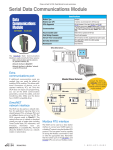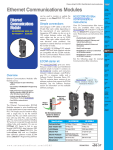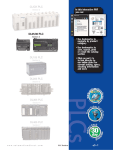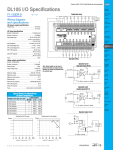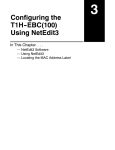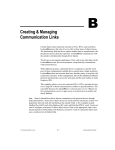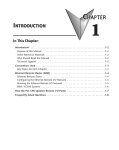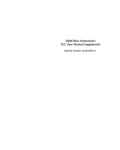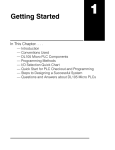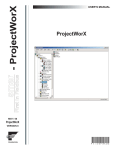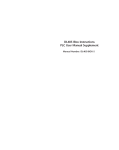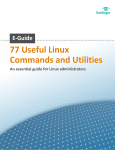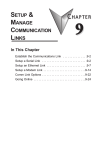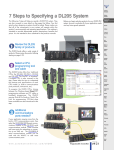Download DL205 Communications Modules
Transcript
Serial Data Communications Module Specifications Data Communications Module D2-DCM <---> Module Type Modules per CPU CPUs Supported Intelligent 7 maximum, slot 1 or higher D2-240 (firmware V1.8 or later), D2-250-1 and D2-260 RS-232/422 signal levels, DirectNET Master/Slave, K-sequence or Modbus RTU Slave protocol, Baud rate selectable from 300 baud to 38.4 Kbaud, Odd or No parity, DirectNET HEX or ASCII mode Belden 9729 or equivalent (for RS-422) Communications Recommended Cable Field Wiring Connector Internal Power Consumption 25-pin D-shell connector 300 mA maximum at 5 VDC, (supplied by base power supply) Operating Environment 0ºC to 60ºC (32ºF to 140ºF), 5% to 95% humidity (non-condensing) Manufacturer Koyo Electronics DCM as additional serial port The D2-DCM Data Communications Module is used primarily for three reasons: • Extra communications port to connect a PC, operator interface, etc. • Network interface to DirectNET • Network interface to a Modbus® network using the RTU protocol C-more HMI panel Extra communications port If additional communication ports are needed, they can easily be added by installing DCM modules. This allows additional connections of devices, such as operator interfaces, PCs, etc. Since the DCM does not require any programming, you can set the DCM communication parameters, connect the cables, and start transferring data. Make sure the device has a DL205 compatible driver. DirectNET network interface The DCM can be used as a network interface for applications requiring data to be shared between PLCs, or between PLCs and an intelligent device such as a host PC. The DCM connects easily to DirectNET. This network allows you to upload or download virtually any type of system data including Timer/Counter data, I/O information, and V-memory information from any DirectLOGIC or compatible PLC. The DCM allows the DL205 to function as a network master or network slave. 4–56 PLC Products Master/Slave Network Connect the DCM to our MDM-TEL serial modem (see the Communication Products section for details on the modem) DCM as master RS232 to RS422 Converter D2–240 slave D2–DCM slave DL–405 CPU (bottom port) D3–340 slave Modbus RTU interface The DCM can be used as a slave station interface to connect your DL205 system to a Modbus® network using the Modbus RTU protocol. The host system must be capable of issuing the Modbus commands to read or write the appropriate data. Remember that the bottom port on the D2-250-1 and D2-260 CPUs can act as a Modbus master. 1 - 80 0 - 633 - 0405 Serial Module for WinPLC and EBC Systems PLC Overview DL05/06 PLC Serial Communications Module for WinPLCs & EBCs H2-SERIO <---> Serial I/O module for WinPLCs Add serial ports to your WinPLC system by simply plugging the H2-SERIO modules into the DL205 I/O base. This serial module is used exclusively with the WinPLC. The WinPLC communicates with the H2–SERIO module across the DL205 backplane. Up to ten serial ports on a WinPLC system The WinPLC has one built-in serial port. You can add as many as nine additional serial ports for Think & Do Studio or Think & Do Live! applications requiring multiple serial devices, such as barcode scanners. Connect to just about any serial device that communicates ASCII protocol. The H2-SERIO can also serve as a Modbus RTU slave. Processing large amounts of serial data with a WinPLC H2-SERIO Specifications Module Type # of Serial Ports per Module # of modules supported per WinPLC # of modules supported per EBC node Protocols Supported Connector Power Consumption Operating Environment Manufacturer Intelligent module for use with H2–WPLC*-** or PC/EBC system 3 DL205 PLC 3 3 Serial ASCII and Modbus RTU slave RJ12 jack DL305 PLC DL405 PLC 210 mA @ 5 VDC 0 to 60°C (32°F to 140°F), 5% to 95% RH (non-condensing) Field I/O Host Automation Products, L.L.C. Separate communications parameters for each port Using H2-SERIO in a PC-based control EBC system Use Think & Do software packages to set baud rate, parity, data bits, and stop bits for each serial port. Choose from 300 baud to 57.6K baud communication speeds. Think & Do Studio or Think & Do Live! allows each port to be designated as a Modbus slave or a generic serial device. Each port on the H2–SERIO module is capable of full hardware handshaking. Think & Do Studio version 6.5 supports the use of up to three H2-SERIO modules per EBC node in a PC-based control system. The master must be a PC running Studio 6.5 or later. This does not apply to a WinPLC system with an ERM module used for remote I/O. Easy serial communications DL105 PLC The Think & Do features listed on this page for the WinPLC (receiving and manipulating data) also apply to a PC running the Think & Do software. Software C-more HMIs Other HMI AC Drives Motors Steppers/ Servos Motor Controls Proximity Sensors Photo Sensors All Think & Do PC control software products include advanced string and array functions that make transmitting, receiving and manipulating serial data a snap. Limit Switches Encoders Current Sensors Pushbuttons/ Lights Pin Assignments for H2-SERIO ports 1 0V Power (-) Connection (GND) 2 CTS Clear to Send 3 RXD Receive Data (RS-232) 4 TXD Transmit Data (RS-232) 5 RTS Request to Send 6 0V Signal Ground (GND) Process 6 Relays/ Timers 1 Comm. RJ12 (6P6C) Female Modular Connector TB’s & Wiring While the H2-SERIO module will support virtually any serial device, processing large amounts of serial data will increase the system response time. This is important to consider when using multiple H2-SERIO modules, especially in a WinPLC local base with an H2-ERM or H2-CTRIO. Power Circuit Protection Enclosures Appendix Part Index w w w. a u to m at i o n d i re c t . c o m / d l 205 PLC Products 4–57 Ethernet Communications Modules Ethernet Communications Module H2-ECOM <---> H2-ECOM100 <---> H2-ECOM-F <---> H2-ECOM100 IBox communications instructions can be used to monitor or update the program in any DirectLOGIC PLC on the network. Simple connections Over 25 Communications IBox instructions are available when using the H2ECOM100 with a DL250-1 or DL260 PLC and DirectSOFT5 programming software. These easy-to-use instructions allow you to: • Enable/disable module DHCP • Read/write module IP, Gateway and Subnet Mask addresses • Read/write module ID, Name and Description • Send E-mail messages • Read/Write PLC memory to networked Hx-ECOM100 modules • Read/Write PLC memory to networked Hx-ECOM(-F) modules See the following page for example Communications IBox instructions. Use Category 5 UTP cables or 62.5/125 ST-style fiber optic cables depending on the requirements of your application. Inexpensive UTP cables can be run up to 100 meters between nodes, and fiber optic cables can be run up to 2,000 meters. Fiber optic cables virtually eliminate electrical noise problems. Use repeaters to extend distances and expand the number of nodes. Our HA-TADP (10/100Base-T) PC network adapter card and E-SW05U Ethernet switch is compatible with the ECOM modules. See the Communications Products section for information on these items. ECOM starter kit Overview Ethernet Communications Modules offer features such as: • High-speed peer-to-peer networking of PLCs • Fast updates with DirectSOFT Programming Software • High-performance access for Human Machine Interface (HMI), ERP, MES or other Windows-based software • Industry standard Modbus TCP Client/Server Protocol (H2-ECOM100) • Free SDK for custom drivers • Easy setup The Ethernet Communication (ECOM) Modules represent a price breakthrough for high-speed peer-to-peer networking of PLCs. No longer are you forced to designate a single PLC to be the network master. Any PLC can initiate communications with any other PLC. Link your PLCs with PCs using industry standard Modbus TCP protocol connected through standard cables, hubs, and repeaters. Or, use our KEPDirect I/O Server to link to your favorite HMI/SCADA, data historian, MES or ERP software to DirectLOGIC PLCs. Our LookoutDirect HMI and our DataWorx data collection software include ECOM drivers. DirectSOFT Programming Software 4–58 PLC Products The H2-ECOM-START gives you everything you need to make your first Ethernet network simple to build. It contains an H2-ECOM module and instruction manual, a network adapter card (PCI) for your PC, a crossover cable, and a Software Product Showcase Demo CD. The CD contains demo versions of our software products that support the ECOM Modules. See the Software Products section for information on the available software packages. Message in The H2-ECOM100 supports the Industry Standard Modbus TCP Client/Server Protocol Message is sent out of port only connected to device See the Communications section for details on the E-SW05U Ethernet Switch Specifications Communications Data Transfer Rate Link Distance Ethernet Port H2-ECOM H2-ECOM100 H2-ECOM-F 10Base-T Ethernet 10/100Base-T Ethernet 10Base-FL Ethernet 10 Mbps max. 100 Mbps max. 10 Mbps max. 100 meters (328 ft) 100 meters (328 ft) 2,000 meters (6,560 ft) RJ45 RJ45 ST-style fiber optic Ethernet Protocols TCP/IP, IPX TCP/IP, IPX, Modbus TCP, DHCP, HTML configuration TCP/IP, IPX Power Consumption Manufacturer 450 mA @ 5VDC 300 mA @ 5 VDC 640 mA @ 5 VDC Host Automation Products, L.L.C. 1 - 80 0 - 633 - 0405 Ethernet Communications Modules Modbus TCP support PLC Overview DL05/06 PLC Modbus TCP communications architecture The H2-ECOM100 supports the industry standard Modbus TCP Client/Server protocol in addition to the standard IP and IPX protocols. This allows the DL205 PLC with an H2-ECOM100 module to serve as a client (master) or as a server (slave) on a Modbus TCP Ethernet network. The H2-ECOM100 can actively issue Modbus commands to other nodes or devices on the Modbus TCP network or simply respond to connected Modbus TCP clients. PLC-to-PLC communications PLC-to-PLC or PLC to a Modbus TCP device communications can be accomplished using standard Read from Network (RX) and Write to Network (WX) instructions (DL240/250-1/260, all H2 series ECOMs and all DirectSOFT versions). If you’re using our new DirectSOFT5 programming software, a DL250-1 or DL260 PLC and an H2-ECOM100, you can use fill-in-the-blank IBox instructions to simplify your communications programming. The H2-ECOM100 supports the ECOM100 Configuration IBox for use with the ECRX and ECWX IBox instructions to read/write to other ECOM(100)s. All H2 series ECOM modules support the NETCFG Configuration IBox for use with the NETRX and NETWX IBox instructions to read/write to other ECOM modules (remember DL250-1/260 and DSOFT5 required). The Communications IBox instructions execute with built-in interlocking to greatly simplify communications programming. H2-ECOM100 has e-mail capability! DL105 PLC DL205 PLC DL305 PLC DL405 PLC Field I/O Software C-more HMIs ECOM100 Configuration IBox NetEdit3 software ECOM100 Read Network IBox NetEdit3 Software ships free with the ECOM User Manual. Use NetEdit3 to configure the ECOM modules for your network. Flexible addressing allows you to use your choice of protocols and identifying methods. Assign each module a number or a name or both. You don’t have to use an IP address, but you can if it’s necessary for your network. NetEdit3 uses two protocols for PC-to-PLC communications: IPX and TCP/IP. The NetEdit3 screen displays all identifiers and troubleshooting information for each module on the network. You can use NetEdit3 to adjust parameters for PLC-to-PLC communications by clicking on Advanced Settings. The network identifiers can also be changed from DirectSOFT Programming Software. Other HMI Choose your slot ECOM100 Send EMail IBox The H2-ECOM100 Send EMail (ECEMAIL) IBox instruction allows the module to behave as an e-mail client and send an SMTP request to your SMTP Server to send a specified e-mail message to the e-mail addresses in the in IBox’s To: field. The Body: field allows you to embed real-time data in your e-mail message. The DL50-1/260 CPU and DirectSOFT5 are required to use the IBox instructions. Motors Steppers/ Servos Motor Controls Proximity Sensors Photo Sensors Limit Switches Encoders Current Sensors Pushbuttons/ Lights The ECOM modules plug into any I/O slot (excluding slot 0) of any local DL205 I/O base. The module maintains identification data, descriptive information, and communication parameters for PLC-toPLC communications in flash memory. Disconnect power before installing or removing any PLC module. 205 AC Drives Process Relays/ Timers Comm. TB’s & Wiring Power CP U S lot 0 S lot 1 S lot 2 S lot 3 S lot 4 No! Circuit Protection Enclosures Note: Use D2-240, D2-250, D2-250-1 or D2-260 CPUs with the ECOM modules. The D2-230 CPU and D2-CM bases do not support the ECOM modules. Appendix Part Index w w w. a u to m at i o n d i re c t . c o m / d l 205 PLC Products 4–59




